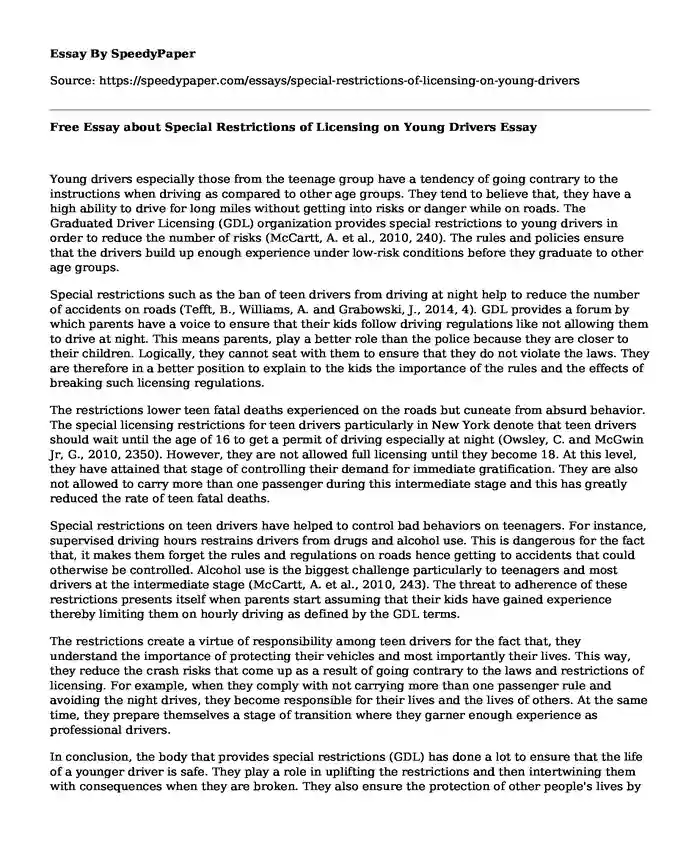Young drivers especially those from the teenage group have a tendency of going contrary to the instructions when driving as compared to other age groups. They tend to believe that, they have a high ability to drive for long miles without getting into risks or danger while on roads. The Graduated Driver Licensing (GDL) organization provides special restrictions to young drivers in order to reduce the number of risks (McCartt, A. et al., 2010, 240). The rules and policies ensure that the drivers build up enough experience under low-risk conditions before they graduate to other age groups.
Special restrictions such as the ban of teen drivers from driving at night help to reduce the number of accidents on roads (Tefft, B., Williams, A. and Grabowski, J., 2014, 4). GDL provides a forum by which parents have a voice to ensure that their kids follow driving regulations like not allowing them to drive at night. This means parents, play a better role than the police because they are closer to their children. Logically, they cannot seat with them to ensure that they do not violate the laws. They are therefore in a better position to explain to the kids the importance of the rules and the effects of breaking such licensing regulations.
The restrictions lower teen fatal deaths experienced on the roads but cuneate from absurd behavior. The special licensing restrictions for teen drivers particularly in New York denote that teen drivers should wait until the age of 16 to get a permit of driving especially at night (Owsley, C. and McGwin Jr, G., 2010, 2350). However, they are not allowed full licensing until they become 18. At this level, they have attained that stage of controlling their demand for immediate gratification. They are also not allowed to carry more than one passenger during this intermediate stage and this has greatly reduced the rate of teen fatal deaths.
Special restrictions on teen drivers have helped to control bad behaviors on teenagers. For instance, supervised driving hours restrains drivers from drugs and alcohol use. This is dangerous for the fact that, it makes them forget the rules and regulations on roads hence getting to accidents that could otherwise be controlled. Alcohol use is the biggest challenge particularly to teenagers and most drivers at the intermediate stage (McCartt, A. et al., 2010, 243). The threat to adherence of these restrictions presents itself when parents start assuming that their kids have gained experience thereby limiting them on hourly driving as defined by the GDL terms.
The restrictions create a virtue of responsibility among teen drivers for the fact that, they understand the importance of protecting their vehicles and most importantly their lives. This way, they reduce the crash risks that come up as a result of going contrary to the laws and restrictions of licensing. For example, when they comply with not carrying more than one passenger rule and avoiding the night drives, they become responsible for their lives and the lives of others. At the same time, they prepare themselves a stage of transition where they garner enough experience as professional drivers.
In conclusion, the body that provides special restrictions (GDL) has done a lot to ensure that the life of a younger driver is safe. They play a role in uplifting the restrictions and then intertwining them with consequences when they are broken. They also ensure the protection of other people's lives by reducing insurance costs to teenage groups. By so doing, teen drivers will get enough experience before they graduate to another level.
References
McCartt, A.T., Teoh, E.R., Fields, M., Braitman, K.A., and Hellinga, L.A., 2010. Graduated licensing laws and fatal crashes of teenage drivers: a national study. Traffic injury prevention, 11(3), pp.240-248.
Owsley, C. and McGwin Jr, G., 2010. Vision and driving. Vision Research, 50(23), pp.2348-2361.
Tefft, B.C., Williams, A.F. and Grabowski, J.G., 2014. Driver licensing and reasons for delaying licensure among young adults ages 18-20, United States, 2012. Injury epidemiology, 1(1), p.4.
Cite this page
Free Essay about Special Restrictions of Licensing on Young Drivers. (2022, Feb 23). Retrieved from https://speedypaper.net/essays/special-restrictions-of-licensing-on-young-drivers
Request Removal
If you are the original author of this essay and no longer wish to have it published on the SpeedyPaper website, please click below to request its removal:
- If You Wanted to Learn, You Would, Education Essay Sample
- Free Essay on Addressing the Issue of Eating Disorders from a System's Perspective
- Free Essay Sample for Students: Food and Emotions
- Free Essay on US Foreign Policy and Potential Traumatic Consequences
- Research Paper Sample on Women's Rights and Funding for Family Planning
- Essay Example on Decision-Making in Public Health Spending
- Free Essay: Impacts of Climate Change to the World
Popular categories





